Part 2 of 2
Known as the “winningest pilot in the history of air racing,” Jon Sharp is a legend known for building fast planes and pushing them to the limit. Last week we wrote about Jon and his career working at Lockheed Martin’s Skunk Works, this time we’re jumping in the cockpit with him to examine his career in air racing.

It’s hard to believe, but Jon fell into air racing almost entirely by accident. When he purchased his first airplane in 1978, a Cassutt Special named “Bilbo” from Dave Bice, his main interest was flying it around.
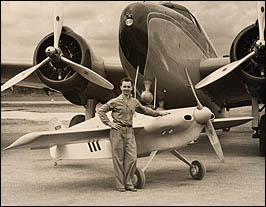 Cassutt Special designer Captain Tom Cassutt with the “Cassutt #1” in 1954.
Cassutt Special designer Captain Tom Cassutt with the “Cassutt #1” in 1954.
Not long after buying the plane came a call that would change both Jon and air racing forever. Bob Downey, an old-time air-racing pilot known as the “Ole Tiger” and an air racing legend in his own right, called his friend Dave Bice to ask him to participate in an upcoming air race in Mexicali, Mexico. When Dave mentioned he had sold the plane to Jon, Bob called him next – and it’s a pretty easy guess how that call ended.

Preparation for that first race in Mexicali was no easy task and took about a month. Jon and his fledgling team worked long hours building a trailer and readying the aircraft. In addition to the solid support of his wife Patricia (which would continue throughout his racing career), Jon also benefitted with help from friend and former work colleague (from George Applebay’s sailplane shop) Steve Hill, who would function as his crew chief in Mexicali.
Race day came up pretty quick, and I asked Jon how he felt, sitting in the cockpit of Bilbo in his final moments before takeoff:
“Sitting on that runway with the race about to start, and six other planes with far-more experienced pilots right next to me, I was absolutely petrified. My nerves were completely shot and stayed that way until the engine started. I ended up placing dead last on that first race, mainly due to the typical rookie mistake of ballooning up in the turns. That was the first air race I ever saw, and it was from the cockpit.”
“I finished the race and talked with Bob (Downey), who had been watching the race from below and he gave me some pointers on how to stop that. Bob also let me use his personal metal prop so I could switch out the wooden one I was using. That wooden prop would spin at maybe 2,900 or 3,000 RPM’s max., but the metal prop spun around 3,700 or 3,800 RPM, which was a huge improvement. With help from Bob, there were two more races that weekend where I did much better.”
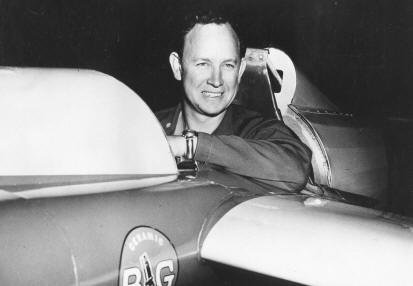 Bob Downey
Bob Downey
From the time he competed in that first race, Jon was hooked.
“As soon as I participated in that first race I was hooked and wanted to get better. I got home from the races and hadn’t been there two hours before I ordered my own metal prop. And I watched for that UPS truck for a solid month before it got there,” remembers Jon.
Jon was mentored by Bob for that race, and many more to come.
“Bob Downey acted as a sort of pilot instructor towards me. We would go over the race route, and many times Bob was already familiar with the track, so he would provide suggestions about the race from start to finish, different turns etc.,” says Sharp.
Jon originally raced in the Formula 1 race class, which changed to International Formula 1 (or IF1) in 1981 after a merger with the International Formula Midget class. As his racing skills increased, Jon started gaining sponsors, one of the first being Aeromag. In recognition of this, he changed the named of his plane from “Bilbo” to “Aero Magic.”
Aero Magic flew from 1981 until 1989, performing well, with competition wins in 1982 and 1986. He also won the Fastest Qualifier Trophy at Reno twice. Jon married his wife Patricia in 1989 and decided to move to California, putting air racing on the back burner for 8-10 months. Early in the year, he discovered that the wing on Aero Magic, while top-of-the-line when originally purchased, was far from the best available in 1990. After contemplating several ideas such as building a composite wing for Aero Magic, he ended up deciding to start with a clean sheet of paper and build a new airplane.
The new plane was to be christened “Nemesis”, and would take over a year to build. Nemesis weighed in at 520 lbs. and was powered by a blueprinted Continental 0-200, eventually producing well over 100hp and RPM’s over 4,000 (manufacturers redline was 2,750).
Jon describes the tooling process: “the parts for Nemesis were made from with a combination of HDU and polystyrene molds that were all hand carved with a wet bucket and brush hand-layup technique and cured in what we called the “Mojave-clave”, which is a 120 degree hanger in mid-summer Mojave, CA.”
 Nemesis next to the SR-71 Blackbird at Lockheed Martin Skunk Works
Nemesis next to the SR-71 Blackbird at Lockheed Martin Skunk Works
The combination of Jon’s skill on the track coupled with the well-designed Nemesis resulted in an absolutely unstoppable duo. Nemesis made its debut in 1991 at the Reno Air Races. Upon seeing the plane, another 1F1 pilot, Bruce Bohannon said to Jon: “this plane is either going to be our nemesis or yours.” After watching a qualifying run, he told Jon, “I figured it out.”
Nemesis went on to win 47 of 50 races entered from 1991 – 1999. Two of the losses were the very first and second races, the first due to Jon hearing a noise he’d never heard before, and the second the result of prop testing. Throughout its 9-year career, Jon, Nemesis, and the Nemesis Air Racing Team would live their motto “Chase the Dream…Not the Competition”, while amassing 9 Gold Reno Championships, receiving the Fastest Qualifier Trophy 6 times and winning four Pulitzer Aviation Trophies.
Air racing is of course an inherently dangerous sport. I asked Jon what one of the most shocking things he saw was and he stated: “I saw a gentleman parachute out of his Corsair once in 1995 at a race in Phoenix. His plane caught fire, and he hit the fire bottles and it went out. Well, the fire came back and he was forced to step onto the wing and parachute out of the plane.”
“Throughout its entire racing career, Nemesis had but a single problem in its life. On my very last landing at Mojave, I got a flat tire as I was landing and almost skidded off the runway. After that, I made it safely to Oshkosh, WI, for the official Nemesis retirement at the EAA Oshkosh AirVenture before it went to the Smithsonian. After retirement, I found myself in the world of gambling.” says Jon.
In 2000 Patricia, while at the hangar working, received a phone call asking if they would be ok with housing Nemesis in the Smithsonian, next to the Enola Gay, SR-71 Blackbird and the Space Shuttle Enterprise to be exact. Jon and Patricia of course agreed and donated Nemesis to the museum where it resides today. Nemesis has been described by the National Air and Space Museum as: “The most successful aircraft in air racing history.”
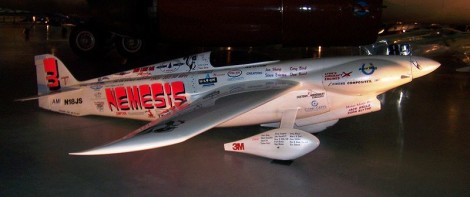 Nemesis inside the National Air & Space Museum
Nemesis inside the National Air & Space Museum
After twenty years of racing, Jon sure as heck wasn’t done, and in 2000 started drawing and sketching designs for a completely new aircraft. After several iterations, the proposed designs were only offering gains of 2, 3 or 4 mph.
“We weren’t interested in spending the money to build a plane that we weren’t even sure would be faster than what we already had. After careful thought, we decided to move up into the Sport racing class, which would allow us to use a larger engine and realize a larger speed gain. This plane would be called the NemesisNXT,” says Sharp.
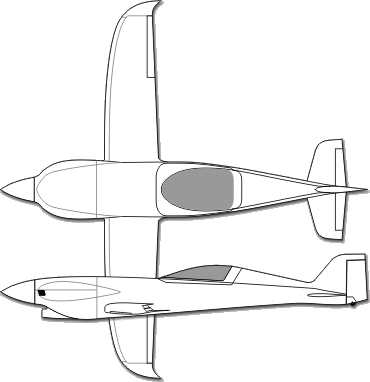
Unfortunately, not long after Jon announced he was leaving IF1 and moving into the Sport-class, the rules were adjusted, requiring all Sport-class planes be kit airplanes, with a minimum of 5 kits sold. Forced to join the kit business or not compete, (Jon likens it to having the goalposts moved in a football game), he managed to get 5 deposits in five weeks on the NemesisNXT – despite the fact it wasn’t finished and had never been flown.
Jon’s friendship with Chuck Miller, President of Coastal Enterprises (manufacturers of Precision Board Plus polyurethane in Orange, CA), meant he was able to secure a donation of Precision Board for the tooling required to build NemesisNXT. The importance of this will be especially clear to anyone familiar with the costs associated with bringing an aircraft from concept to reality.
According to Jon, “We used Precision Board Plus PBLT-20 to make molds for the leading edge closeouts, the horizontal tail, production parts for the leading edges, interior components, the vertical tail, and as a mold for the 90 gallon gas tank. All of the molds were CNC machined, which resulted in our most accurate airframe ever produced. Precision Board, with its tight cell structure and ease of machinability enabled us to bring our first computer-designed aircraft to life.”
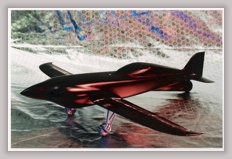
Because all of the molds were machined so accurately, Jon’s Chief Aerodynamicist Daren Kimura was able to accurately predict performance and stability information. Jon’s team also produced a flight simulator for the NXT using open-source code and Jon was able to simulate races before even flying the plane.
The NemesisNXT debuted in May 2002 at the SAMPE convention in Long Beach, CA, weighing in at 1,200 lbs. empty, 2,200 lbs. loaded. It was powered by a Lycoming Thunderbolt TSIO-540-NXT engine, custom designed by Lycoming engineers working in conjunction with the Nemesis Air engineering team.
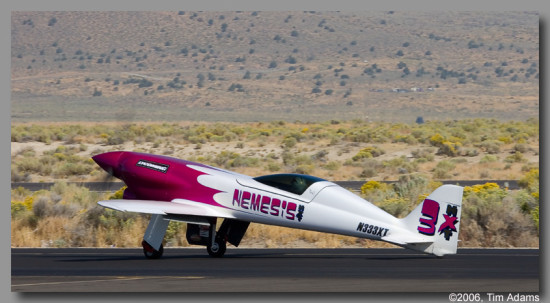 Photo Credit: Tim Adams Photography
Photo Credit: Tim Adams Photography
Jon raced the NemesisNXT for the first time at the 2004 Reno Air Races, resulting in the most terrifying moment of his air racing career. “As I was landing the plane after a qualifying run, the landing gear collapsed, and the plane went down on its belly. I ended up skidding off the runway and into the dirt, but luckily nothing happened and I ended up ok,” says Jon.
The first two years racing NemesisNXT were rough, with technical difficulties hindering both the 2004 and 2005 Reno Air Races. The following year brought the Nemesis team their first of four consecutive Reno Sport / Super Sport Class championships. 2008 saw the NemesisNXT surpass the 400 MPH barrier reaching 409 MPH during a qualifying lap at Reno – an astounding achievement for a plane in the Sport class.
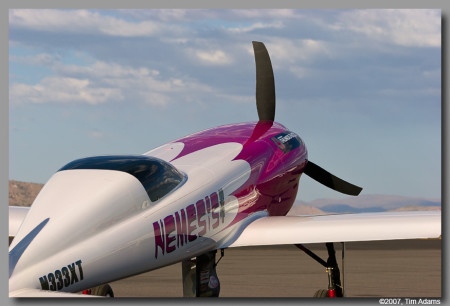 Photo credit: Tim Adams Photography
Photo credit: Tim Adams Photography
The next year, 2009, was Jon’s last year racing, and his most successful. The Reno Air Races that year saw him round up his career with an astounding “Record a Day, and 2 on Sunday” performance. On September 15th at the Reno Air Races, NemesisNXT set a new qualifying record of 412 MPH. This record was faster than the planes in the Unlimited class, over 32 planes including eight P-51 Mustangs and two P-40 Warhawk’s.
September 16th saw the NemesisNXT beat it’s own heat race from 2008 to a new record of 393 MPH.
September 17th saw the team beat the previous day’s heat race record, with a new race speed of 399 MPH.
September 18th, the team beat the previous day’s heat race record again with a top speed of 406 MPH!
September 19th, Jon’s final race, saw him absolutely dominate the class with a championship race record of 406 MPH, at the same time also winning a record 15th Reno National Championship to complete his career.
I asked Jon what his most memorable moments were in his air racing career and he said: “In the thirty years I competed in the air racing circuit, my most memorable moments are my very first race victory in 1982, the first victory with Nemesis in 1991, and the bookend with NemesisNXT in 2009.”
“What is my favorite part of air racing? The checkered flag! It’s a great feeling as you cross that line.”
-Jon Sharp
 Photo credit: Air Racer: Chasing the Dream
Photo credit: Air Racer: Chasing the Dream
Please see additional information about Jon Sharp at nemesisnxt.com.
Jon Sharp and NemesisNXT have also been featured in Air Racer: Chasing the Dream, a documentary shot and directed by Christopher Webb.
This is a preview of Air Racer: Chasing the Dream